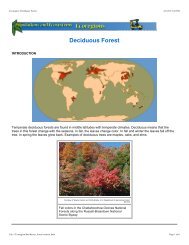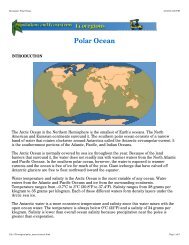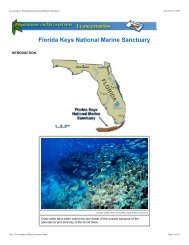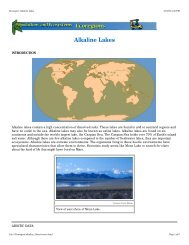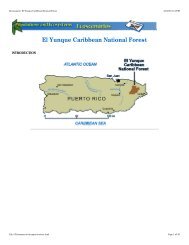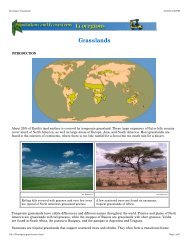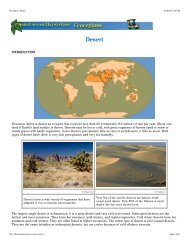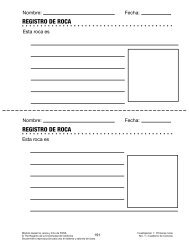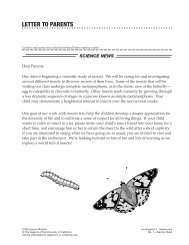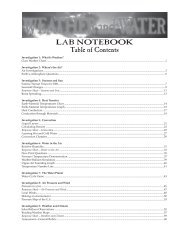Ecoscenarios Combined - FOSSweb
Ecoscenarios Combined - FOSSweb
Ecoscenarios Combined - FOSSweb
Create successful ePaper yourself
Turn your PDF publications into a flip-book with our unique Google optimized e-Paper software.
Ecoscenario: Monongahela National Forest<br />
4/16/03 3:20 PM<br />
In 1905 the U.S. Congress gave the Forest Service money to determine which watersheds should be protected. The<br />
Forest Service needed to acquire the rights to forested land near these watershed to keep them from being damaged. The<br />
Weeks Act in 1911 allowed it to do this. The land that became Monongahela National Forest was among the first areas<br />
the Forest Service purchased.<br />
Most of the forested areas in Monongahela National Forest today are secondary forests. The old-growth trees were clearcut<br />
between 1880 and 1920, because bigger trees mean better boards with fewer knots. Logging practices continue in<br />
Monongahela National Forest, such as removing single trees or clear-cutting 10-hectare (25-acres) blocks.<br />
Current logging laws<br />
Some government officials, such as Georgia representative Cynthia McKinney, are sponsoring an act that would end the<br />
sale of timber from federal lands, and would help restore 100 years of damage to national forests.<br />
Before leaving office, President Bill Clinton signed a plan that would make 24 million hectares (60 million acres) off limits<br />
to new roads and most logging. This plan includes 31% of all U.S. Forest Service lands. Under this plan, some current<br />
logging operations could continue, but new projects would not be allowed. As of spring 2002, this plan was still under<br />
review.<br />
THE DEBATE<br />
Before making decisions that affect an ecosystem, it is important to gather information from a variety of sources. Below<br />
are the views of several individuals or groups that have an interest in the future of the Monongahela National Forest. After<br />
each quote the hyperlink goes to the original source of the quote. Refer to these sites for more information.<br />
Use the information provided to decide where you stand on this debate.<br />
DEBATE: How should logging be conducted in national forests?<br />
People who support increased logging in national forests<br />
Steven J. Milauskas, forest operations specialist, West Virginia University Appalachian Hardwood Center, What Is Low-<br />
Impact Logging?<br />
"Generally, gentle logging systems incorporate several practices that most foresters, landowners, and conscientious<br />
loggers could agree on regardless of the type of equipment used...having a good understanding among landowner, logger,<br />
and forester of how the site will be harvested, what will be removed, how it will be removed, and measures taken to protect<br />
and enhance the remaining stand of trees."<br />
http://www.wvu.edu/~agexten/forestry/logging.htm<br />
Logging company operator<br />
"There are new laws in place that regulate how logging operators conduct the logging so that we protect the environment<br />
and don't pollute the rivers. If we increase our production, we still have to follow those guidelines. If we don't, we get hit<br />
with some pretty big fines."<br />
West Virginia Logging Sediment Control Act<br />
"The law, and accompanying regulations, empowers the Division of Forestry to issue compliance orders to correct<br />
problems and, when necessary, to suspend a logging operation until specified corrections are made to bring the operation<br />
into compliance with the law. The operation may be immediately suspended when human life is endangered,<br />
uncorrectable damage to the environment is imminent, an operator is not licensed, uncorrectable water pollution may<br />
result, or a certified logger is not supervising the operation."<br />
http://www.wvu.edu/~exten/depts/af/ahc/wvlsca.pdf (pdf file)<br />
People who discourage increased logging in national forests<br />
Woodworker<br />
"A lot of products come from the forest without having to cut all of the trees down. If the forest is clear-cut, all of those<br />
industries will be affected."<br />
William N. Grafton, wildlife specialist, West Virginia University Extension Service, Forest Provides Income from Crafts,<br />
Edibles, and More<br />
"A typical logging operation removes only the best wood and leaves the rest behind. This 'rest' includes the stumps,<br />
knots, burls, and tree forks that craftsmen prefer for bowls, carvings, tabletops, etc. These tree sections contain the<br />
fancy, wavy, swirling grain patterns valued by craftsmen."<br />
file:///Ecoscenario/mononga/content.html<br />
Page 9 of 11



